Abstract
In order to address the theoretical deficiencies present in the current literature regarding the willingness to utilize shared transportation—specifically the fragmented influencing factors and the ambiguous cultural regulatory mechanisms—this research employed a meta-analytic methodology. Adhering to the PRISMA guidelines, a systematic screening of 35 empirical studies was conducted (17 in Chinese and 18 in English), which collectively examined 21 potential predictor variables. Following the execution of heterogeneity tests and assessments of publication bias, a random-effects model was applied for the analysis. The results reveal that attitude, subjective norms, and performance expectations exhibit medium effect sizes, while perceived behavioral control, social influence, and trust show weak effects. Conversely, perceived risk is found to have a significant negative impact. Further analysis of moderating effects indicates that collectivist cultures significantly reduce the strength of the effects of subjective norms (Δβ = −0.047) and social influences (Δβ = −0.139). Additionally, the influence of subjective norms is more pronounced in cultures characterized by low uncertainty avoidance (0.371 vs. 0.265). This study offers a theoretical framework for the cross-cultural adaptation of shared transportation systems and establishes an empirical basis for the differentiated development of sustainable urban transportation policies.
1. Introduction
The accelerating pace of global urbanization and the continuous rise in motorization levels have placed unprecedented pressure on urban transportation systems, with traffic congestion and environmental pollution emerging as critical challenges. Despite the implementation of various traffic demand management (TDM) policies—such as license plate restrictions, congestion pricing, and bus priority measures—these issues remain inadequately addressed. Furthermore, structural deficiencies in traditional public transportation systems, particularly in “last-mile” connectivity and service coverage, continue to severely constrain their effectiveness in mitigating urban mobility challenges. Against this backdrop, shared mobility models—supported by big data analysis, the Internet of Things (IoT), and information technologies—have emerged as a transformative solution. Services such as bike-sharing, e-scooter sharing, car-sharing, and ride-pooling have become deeply integrated into daily life.
Academic research on shared mobility has primarily focused on three key areas: (1) travel pattern analysis, (2) determinants of usage behavior, and (3) sustainability impact assessment. Studies on user adoption intentions are predominantly grounded in technology acceptance theories, including the theory of reasoned action (TRA), which establishes the influence of attitudes and subjective norms on behavioral intentions; the theory of planned behavior (TPB), which extends the TRA by incorporating perceived behavioral control, forming a three-dimensional predictive framework; the technology acceptance model (TAM), emphasizing the roles of perceived usefulness and perceived ease of use; the unified theory of acceptance and use of technology (UTAUT), integrating performance expectancy, effort expectancy, and social influence as core determinants [1,2,3,4].
Existing research has empirically validated the impact of key variables such as attitudes and subjective norms, while also expanding to include risk perception and trust [5,6,7,8,9]. However, the findings exhibit significant contextual dependency. For instance, Spears et al. observed a weak attitude–intention linkage (β = 0.12, p > 0.05) in low-density U.S. cities due to low habitual use [10]. Conversely, Richter reported a strong effect (β = 0.38) in high-density Berlin [11]. Si et al. demonstrated that external (e.g., social norms, media influence) and individual factors (e.g., environmental concern, risk appetite, and individual innovation) shape autonomous vehicle usage intention [12]. Meanwhile, the influence of objective environmental factors has also been empirically validated in various studies [13,14,15]. For instance, Zhang et al. innovatively incorporated weather variables into their research on shared bike usage in Asian countries, demonstrating that these variables directly impacted users’ willingness to adopt shared bikes [16]. Additionally, Sendek-Matysiak utilized data from five European countries to quantify the variations in user preferences for vehicles with different drive systems [17]. Furthermore, Nuzzolo et al. employed spatiotemporal data analysis to uncover the spatial differentiation patterns of shared travel intensity in Rome [18].
Recent research findings demonstrate considerable variability, with various influencing factors present across distinct models, and the criteria for assessing effect sizes lack consistency. Consequently, it is imperative to undertake a systematic quantitative synthesis of these results. Meta-analytic techniques, which include standardized procedures such as the integration of effect sizes, evaluation of heterogeneity, and assessment of publication bias, can yield a thorough evaluation of effects and contribute to the development of a cohesive theoretical framework [19,20]. This research adhered rigorously to the PRISMA (Preferred Reporting Items for Systematic Reviews and Meta-Analyses) guidelines in order to perform a systematic review and meta-analysis of global shared mobility behavior studies. The analysis incorporated effect sizes utilizing a random-effects model and conducted moderation effect assessments grounded in cultural dimensions. The objective is to develop a hierarchical model of influencing factors that is both cross-cultural and cross-modal, thereby offering evidence-based insights to inform the development of sustainable transportation policies and the optimization of services.
2. Research Methods and Data Collection
2.1. Literature Search and Selection
As shown in Appendix A Figure A1, based on the PRISMA guidelines, the literature for this study was categorized into two sections: English literature and Chinese literature. In the case of Chinese literature, relevant keywords such as “shared travel” and “shared travel intention” were utilized, and the literature was sourced from databases including CNKI and Wanfang. For the English literature, an initial screening was conducted using databases such as Web of Science and ScienceDirect, employing the keywords “shared travel” and “shared travel intention”, which yielded a total of 1531 publications. This initial set of literature was subsequently refined based on specific selection criteria: (1) the literature must be empirical research; (2) it must investigate the factors influencing the willingness to share travel; (3) it must report either a correlation coefficient or a path coefficient; and (4) the sample size of the survey must be disclosed. Following this rigorous screening process, a total of 35 publications were retained, comprising 17 from Chinese literature and 18 from English literature [5,6,8,9,11,12,21,22,23,24,25,26,27,28,29,30,31,32,33,34,35,36,37,38,39,40,41,42,43,44,45,46,47,48,49].
2.2. Document Coding
In this study, a consistent encoder was utilized to process the literature from various time periods. Upon comparison, no significant discrepancies were observed. The selected literature was encoded to include pertinent details such as author information, correlation coefficients or path coefficients, and sample sizes. In instances where a single piece of literature contained multiple datasets, it was encoded on multiple occasions.
2.3. Variable Declaration
A total of 21 influencing factors were identified in the reviewed literature, including attitude, perceived behavioral control, subjective norms, effort expectation, performance expectation, social influencing, perceived usefulness, perceived ease of use, perceived risk, and trust. Given that perceived ease of use and perceived usefulness can be categorized under effort expectation and performance expectation, these two factors were amalgamated for the purpose of analysis. Additionally, factors such as perceived cost, safety, interest, hedonic motivation, satisfaction, perceived benefit, innovation consciousness, and environmental protection consciousness were represented in no more than five research studies each; consequently, they were excluded from the current analysis. This study focused on the eight influencing factors that were most extensively documented in the literature for further examination.
2.4. Variable Descriptive Statistical Analysis
The data presented in this study includes the sample size and the correlation coefficient, which encompasses both the correlation coefficient and the path coefficient within the structural equation model. A descriptive analysis illustrating the correlation between each influencing factor and the shared mobility intention is provided in Table 1 (the comparison table outlining the influencing factors and their associated empirical literature is presented in Appendix A Table A1).

Table 1.
Descriptive statistics of each influencing factor and usage intention.
As shown in Table 1, performance expectations along with their relationship with shared mobility adoption intention constitutes the most extensively studied factor, accounting for 20 out of 35 empirical studies (57.1%). This is followed by attitude (16 studies, 45.7%) and subjective norms (14 studies, 40.0%), both examined in relation to shared mobility usage intention. In contrast, trust emerges as the least-investigated factor, with only seven studies (20.0%) reporting its path coefficients in shared transportation adoption models.
The empirical research samples concerning risk perception and trust exhibit notable regional concentration, predominantly originating from China. This phenomenon can be attributed to several factors: First, the rapid advancement of shared transportation systems in China, coupled with the high commuting demands in major urban centers, has heightened the relevance of trust- and risk-related issues. Second, the explosive growth of the shared transportation sector in China has led to initial market disarray, exemplified by incidents such as safety concerns associated with Didi Hitch and challenges related to the refunding of deposits for shared bicycles. These circumstances have drawn significant scholarly attention to the themes of risk and trust. Third, the frequent collaborations between shared transportation platforms and academic institutions facilitate researchers’ access to empirical data. Additionally, from a cultural psychology perspective, within a collectivist cultural framework, risk cognition demonstrates unique characteristics of social contagion. Following a singular security incident that is amplified by social media, a collective risk perception can rapidly emerge (as evidenced by trending topics on platforms like Weibo). However, risk compensation is often mediated through institutional trust, such as government regulation, which ultimately diminishes the behavioral inhibition effect, resulting in a relatively low perceived risk effect value.
While direct evidence regarding emerging factors such as hedonic motivation remains scarce (k < 5), interdisciplinary studies indicate that it exerts a considerable influence on gamified transportation applications. Nevertheless, the findings across these studies exhibit considerable variability, highlighting the intricate nature of research pertaining to the motivations behind shared travel behavior. This variability suggests that conventional travel research may not fully account for the significance of non-utilitarian motivations.
3. Empirical Research
3.1. Heterogeneity Test
In meta-analytic research, substantial variations across primary studies—including differences in theoretical frameworks, methodological approaches (e.g., cross-sectional vs. longitudinal designs), sample characteristics (e.g., demographic composition), experimental designs (e.g., randomized controlled trials vs. observational studies), and operational definitions—may lead to significant heterogeneity in pooled effect size estimates. During the meta-analytic process, if the studies exhibit no statistical heterogeneity, either a fixed-effects model or a random-effects model may be employed. Conversely, in the presence of heterogeneity, the random-effects model is preferred for aggregating effect sizes. The assessment of heterogeneity can be quantified using the Q-statistic and the I2 statistic. Specifically, a Q-statistic p-value ≤ 0.1 and an I2 value exceeding 50% suggest the presence of heterogeneity, while a p-value greater than 0.1 and an I2 value ≤ 50% indicate a lack of heterogeneity. The outcomes of the heterogeneity assessment are presented in Table 2.

Table 2.
Results of heterogeneity test.
As shown in Table 2, the I2 values of attitude (I2 = 97.17%, p < 0.001), perceived behavioral control (I2 = 92.40%, p < 0.001), subjective norms (I2 = 94.04%, p < 0.001), effort expectation (I2 = 95.80%, p < 0.001), performance expectation (I2 = 90.30%, p < 0.001), perceived risk (I2 = 92.31%, p < 0.001), social influencing (I2 = 89.86%, p < 0.001), trust (I2 = 90.70%, p < 0.001) exceeded 50%; the random-effects model was chosen to aggregate the effect sizes.
3.2. Publication Bias Test
Publication bias is characterized by the tendency for significant research findings to be more frequently reported and published compared to insignificant or invalid results, leading to a selective distortion of research outcomes within the database. A publication bias test is a statistical approach employed to assess whether research findings are influenced by this publication tendency. Common methodologies for conducting such tests include funnel plots, the Egger test, non-parametric rank correlation (Begg) test, and Fail-Safe number. In the present study, the Egger test was utilized to quantitatively assess the presence of publication bias within the sample. A p-value > 0.05 indicates no evidence of publication bias, whereas a p-value ≤ 0.05 suggests its presence. The findings from the publication bias test are presented in Table 3.

Table 3.
Publication bias test results.
Table 3 indicates that the p-values obtained from the Egger test for the variables of attitude, perceived behavioral control, subjective norm, effort expectation, performance expectation, perceived risk, social influencing, and trust all exceed the threshold of 0.05. This suggests that there is no publication bias present in the analysis.
3.3. Effect Size Analysis
3.3.1. Effect Size Calculation
The meta-analysis presented in this study employed SPSSAU 24.0 software for computations. To mitigate the biases arising from factors such as research contexts and sample characteristics, effect sizes are were from the sample size and the Z-value following Fisher’s z transformation. Initially, Fisher’s z transformation was applied to the correlation coefficients (or path coefficients) obtained from the relevant literature to derive the z-values, as illustrated in Equation (1). Subsequently, the weighted average z-value (z+) is computed based on the sample sizes, as detailed in Equation (2). Finally, the effect size (rz) is determined from the z-values, as represented in Equation (3).
where z represents the variable that adheres to the standard normal distribution, while r denotes the correlation coefficient (or path coefficient) obtained from the existing literature. The term z+ refers to the weighted average of z, Ni indicates the sample size of the i-th study, zi signifies the z value corresponding to the i-th study, and rz represents the effect size.
3.3.2. Effect Value Result
This research employed a meta-analytic approach to quantitatively assess the strength of the correlation between various influencing factors and shared transportation intention. By determining the aggregated effect size, we were able to systematically compare the explanatory power of each predictor variable in relation to the outcome variable. The findings from the effect size calculations are presented in Table 4 and Figure 1, Figure 2, Figure 3, Figure 4, Figure 5, Figure 6, Figure 7 and Figure 8.

Table 4.
Effect size calculation results.
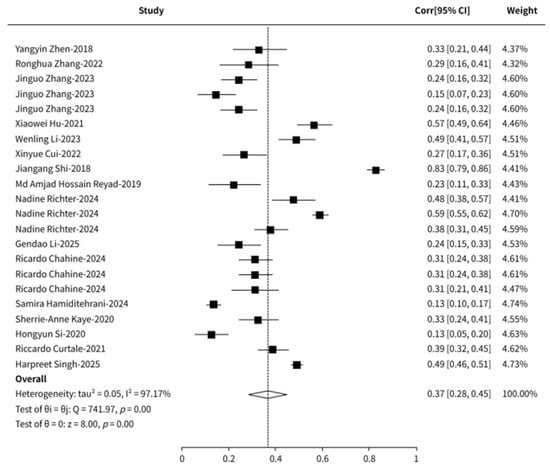
Figure 1.
Influencing factors’ meta-analysis forest plot (attitude) [5,11,22,25,26,28,29,31,35,38,39,41,45,47,48,49].

Figure 2.
Influencing factors’ meta-analysis forest plot (perceived behavioral control) [11,22,25,26,28,29,35,39,41,49].
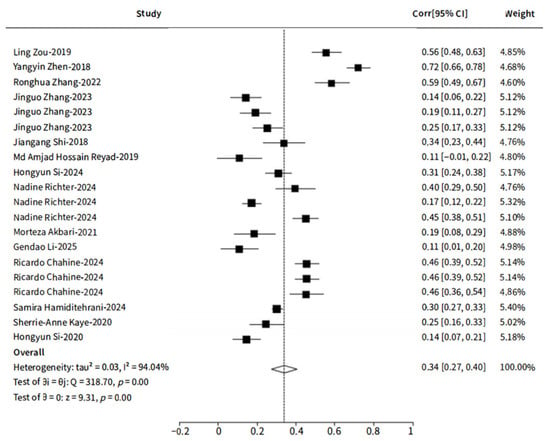
Figure 3.
Influencing factors’ meta-analysis forest plot (subjective norms) [11,12,21,22,25,26,28,29,35,37,38,39,41,49].
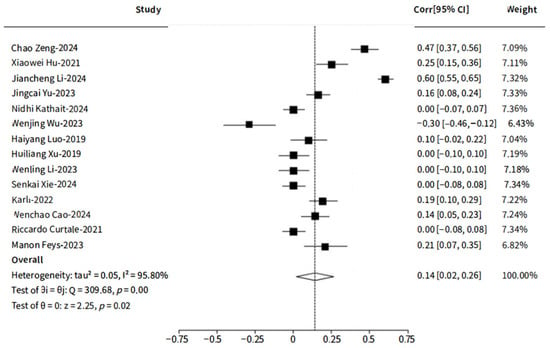
Figure 4.
Influencing factors’ meta-analysis forest plot (effort expectation) [6,9,23,24,27,31,32,33,34,42,43,44,45,47].

Figure 5.
Influencing factors’ meta-analysis forest plot (performance expectation) [6,9,22,23,24,27,30,31,32,33,34,36,37,40,41,43,44,45,46,48].
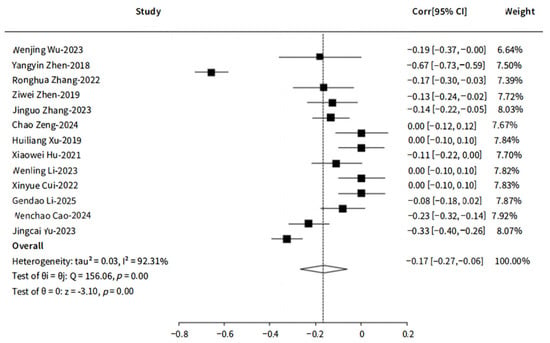
Figure 6.
Influencing factors’ meta-analysis forest plot (perceived risk) [9,22,27,34,38,39,40,41,42,44,45,47,48].
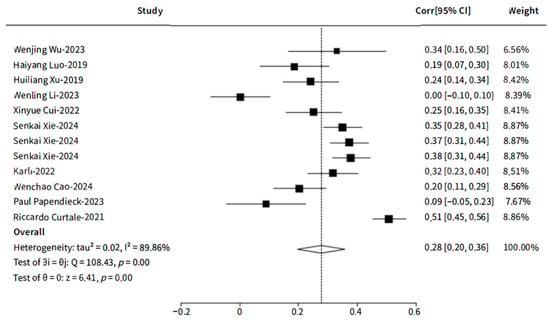
Figure 7.
Influencing factors’ meta-analysis forest plot (social influencing) [6,9,23,30,31,34,43,44,47,48].
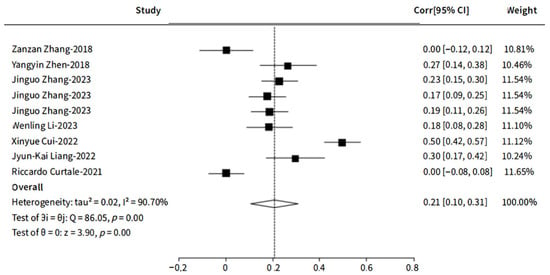
Figure 8.
Influencing factors’ meta-analysis forest plot (trust) [8,31,36,38,41,47,48].
As shown in Table 4 and Figure 1, Figure 2, Figure 3, Figure 4, Figure 5, Figure 6, Figure 7 and Figure 8, based on the criteria established by Cohen, the effect sizes for attitude (0.369), subjective norms (0.340), and performance expectation (0.306) exceed the threshold of 0.3, indicating a moderate level of correlation. Conversely, the effect sizes for perceived behavioral control (0.252), effort expectation (0.143), perceived risk (−0.167), social impact (0.279), and trust (0.208) fall within the range of 0.1 to 0.3, suggesting relatively weak correlations.
Attitudes, subjective norms, and performance expectations significantly impact the willingness to utilize shared transportation. This suggests that users’ favorable assessments of shared transportation, social pressures, and expectations regarding practicality serve as the primary motivators for their engagement with such services. Conversely, the influence of perceived behavioral control, social influence, and trust appears to be limited, indicating that users’ perceptions of their own capabilities, social endorsements, and trust in the platform exert a relatively weak direct effect. Furthermore, perceived risks notably diminish the willingness to engage with shared transportation; however, the magnitude of this effect is relatively small, potentially due to users’ heightened tolerance for risk.
3.4. Sensitivity Analysis
A sensitivity analysis was conducted using the leave-one-out method, which involved removing each included study one by one and then merging the effect sizes. It was also possible to change the inclusion and exclusion criteria or remove certain types of literature before merging the effect sizes again. The results of the sensitivity analysis are shown in Table 5.

Table 5.
Meta-analysis sensitivity test results.
Table 5 indicates that the variation in effect size is relatively minimal following the exclusion of individual studies, suggesting that the research findings are robust.
3.5. Moderating Effect Test
Subjective norms and social influencing factors are shaped by social and cultural contexts. The empirical research literature reviewed encompasses samples from various countries and regions, each characterized by distinct social and cultural backgrounds (as illustrated in Figure 9). This study employed the Hofstede cultural dimension index as a framework for classification [50], focusing on individualism and collectivism (IDV) culture, as well as uncertainty avoidance (UAI), as moderating variables. The objective was to investigate the variations in the impact of subjective norms and social influence factors on the willingness to utilize shared transportation across different cultural settings. Due to data completeness constraints, the analysis was limited to examining the moderating effect of uncertainty avoidance (UAI) on the relationship between subjective norms and the willingness to engage in shared transportation. The findings of this analysis are presented in Table 6.
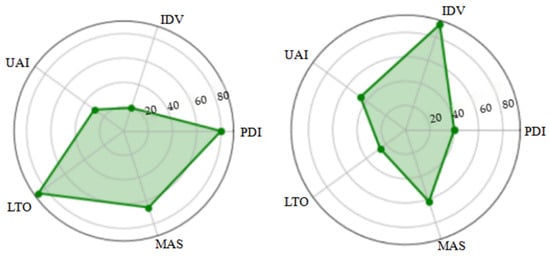
Figure 9.
Hofstede cultural index radar map for China and the United States (Left: China, Right: United States). IDV: individualism vs. collectivism; UAI: uncertainty avoidance; PDI: power distance; LTO: long-term vs. short-term orientation; MAS: masculinity vs. femininity.

Table 6.
Moderating effect test results.
Table 6 reveals that within a collectivist cultural framework, such as that in China, the effect sizes of subjective norms (β = 0.321) and social influence (β = 0.217) on the intention to utilize shared transportation are notably lower than those observed in an individualistic cultural context, exemplified by the United States (subjective norms: β = 0.368; social influence: β = 0.356). This finding suggests that, in collectivist cultures, the impact of social norms on individuals is not primarily conveyed through direct verbal persuasion but rather through non-verbalized norms and contextual cues. Consequently, conventional survey methods may systematically underestimate the true magnitude of social influence in these cultural contexts.
Uncertainty avoidance pertains to the degree to which individuals within a society are willing to accept future uncertainties without experiencing stress. This concept encompasses various elements, including a propensity to evade risks and a deference to authority. In contexts characterized by low uncertainty avoidance, the influence of subjective norms on the intention to utilize shared transportation is notably greater (0.371 vs. 0.265). This finding suggests that individuals exhibiting high levels of uncertainty avoidance demonstrate heightened sensitivity to potential risks and tend to prioritize risk–return evaluations over social references when making decisions.
4. Management Suggestions
Drawing upon research findings, this study proposes several management recommendations aimed at advancing the development of a sustainable transportation system within our nation and promoting the widespread adoption of the shared travel model.
For the influencing factors with large effect sizes, several key interventions are proposed:
- (1)
- Attitude Intervention. It is recommended that operators implement a “carbon footprint visualization system” that utilizes life cycle assessment methodologies to calculate and provide real-time feedback on the environmental benefits associated with individual trips (e.g., “This ride reduces CO2 emissions by 0.5 kg”). This approach aims to enhance users’ behavioral attitudes by fostering a sense of environmental responsibility.
- (2)
- Activation of Subjective Norms. Within collectivist cultural contexts, it is crucial to emphasize the role of descriptive norms. Mobile applications can incorporate spatial analysis features to dynamically generate and display heat maps illustrating shared vehicle usage in nearby areas, thereby leveraging geographic visualization technology to amplify the social demonstration effect. Additionally, a neighborhood carpooling matching algorithm could be developed utilizing data from residential communities to facilitate carpooling for commuting purposes. In contrast, in individualistic cultural contexts, a “friend recommendation points system” could be introduced, whereby users receive incentives, such as a CNY 5 discount coupon, for each successful referral.
- (3)
- Performance Expectation Improvement. It is essential to enhance the human–computer interaction design of the user interface, with a focus on improving the visibility and usability of core functional modules, such as algorithms for predicting real-time traffic conditions.
For the variables exhibiting comparatively low effect sizes, the following are recommended:
- (1)
- Trust Development. It is essential to adopt transparent management practices, which include the disclosure of platform security measures, such as adherence to ISO/IEC 27001 Information Security Management standards, as well as the presentation of driver qualification certification processes and vehicle maintenance records. These actions are aimed at bolstering user confidence.
- (2)
- Risk Mitigation. The integration of security assurance features, such as share itinerary capabilities and emergency assistance buttons, within operational procedures can help alleviate users’ perceived risks. Additionally, the establishment of a collaborative response team comprising representatives from both the platform and government entities is recommended to facilitate timely and authoritative communication regarding major public sentiment, alongside the creation of a risk compensation fund.
5. Conclusions and Prospects
This research employed a meta-analytic approach to assess the overall effect sizes between various influencing factors and the willingness to engage in shared travel. Utilizing the effect size evaluation criteria established by Cohen (1988), the analysis revealed that the comprehensive effect sizes of three variables—attitude, subjective norms, and performance expectation—exhibit a moderately strong positive correlation with the willingness to utilize shared transportation. Conversely, social influence, perceived behavioral control, trust, and effort expectations demonstrate relatively weak correlations. Notably, perceived risk was found to exert a significant negative impact. Furthermore, through the analysis of moderating effects, the study identified variations in the influence of subjective norms and social factors on the willingness to use shared transportation across different cultural contexts, specifically individualistic versus collectivist cultures and levels of uncertainty avoidance. A theoretical model encompassing the interrelations of “culture-psychology-behavior” was developed, elucidating the critical psychological mechanisms that influence the willingness to adopt shared transportation. This model offers a theoretical framework for the cross-cultural adaptation of shared transportation systems and provides an empirical foundation for the tailored formulation of sustainable urban transportation policies.
This research, through a systematic synthesis of existing empirical studies, established general conclusions regarding the mechanisms influencing the willingness to utilize shared transportation, thereby providing a foundation for evidence-based policy formulation and service enhancement. Nonetheless, this study is subject to certain limitations. Firstly, constrained by the scope of the original literature, the analysis focused solely on the direct effects of eight primary variables, neglecting potential mediating mechanisms (such as the role of attitude as a mediator between subjective norms and willingness to use) and moderating variables (such as the impact of economic development levels). Secondly, the geographical distribution of the literature samples included in the analysis exhibits certain biases, which may compromise the cultural generalizability of the findings.
Future research should aim to broaden the scope of investigation by integrating a mediation–moderation effect analysis framework. This approach will facilitate the examination of the transmission pathways and boundary conditions among various influencing factors. Additionally, it is essential to enhance the diversity of the sample population by incorporating research samples from regions with distinct cultural backgrounds, thereby improving the external validity of the findings. Finally, it is essential to move beyond the homogeneous assumption of “shared mobility” by differentiating the mechanisms between micro-mobility (bike-sharing/e-scooters) and ride-pooling services at the modal level, thereby providing evidence for tailored policy-making.
Supplementary Materials
The following supporting information can be downloaded at: https://www.mdpi.com/article/10.3390/su17115216/s1.
Author Contributions
F.G. and L.G. conceptualized the study. F.G. proposed the methodology and validated this study. F.G. finished the data curation and performed formal analysis. F.G. was responsible for investigation and resources as well as wrote the original draft. L.G. supervised this study. All authors have read and agreed to the published version of the manuscript.
Funding
This research received no external funding.
Institutional Review Board Statement
Not applicable.
Informed Consent Statement
Not applicable.
Data Availability Statement
The data used to support the findings of this study have been uploaded as Supplementary Files.
Conflicts of Interest
The authors declare that they have no conflicts of interest.
Appendix A
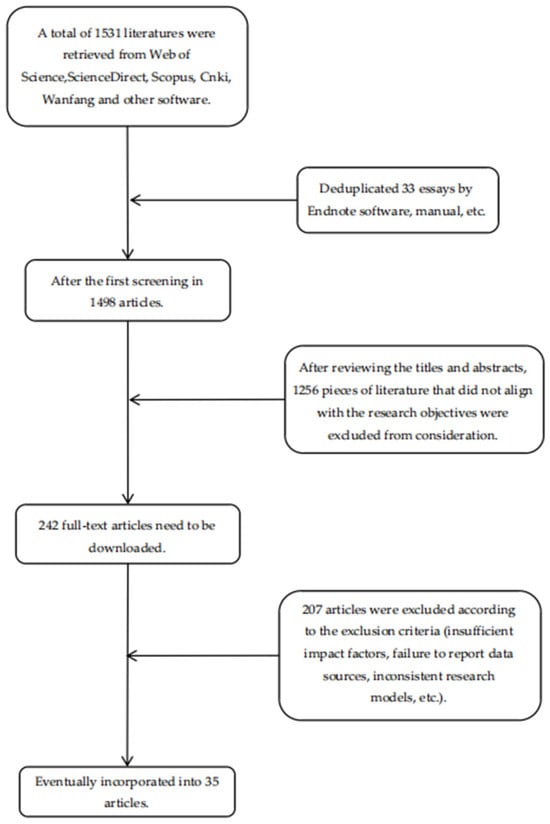
Figure A1.
Literature Screening Flowchart.

Table A1.
Comparison table of influencing factors and empirical literature.
Table A1.
Comparison table of influencing factors and empirical literature.
| Influencing Factor | Reference Label |
|---|---|
| Attitude | [5,11,22,25,26,28,29,31,35,38,39,41,45,47,48,49] |
| Perceived Behavioral Control | [11,22,25,26,28,29,35,39,41,49] |
| Subjective Norms | [11,12,21,22,25,26,28,29,35,37,38,39,41,49] |
| Effort Expectation | [6,9,23,24,27,31,32,33,34,42,43,44,45,47] |
| Performance Expectation | [6,9,22,23,24,27,30,31,32,33,34,36,37,40,41,43,44,45,46,48] |
| Perceived Risk | [9,22,27,34,38,39,40,41,42,44,45,47,48] |
| Social Influencing | [6,9,23,30,31,34,43,44,47,48] |
| Trust | [8,31,36,38,41,47,48] |
References
- Fishbein, M.; Ajzen, I. Belief, Attitude, Intention and Behavior: An Introduction to Theory and Research; Addison-Wesley: Boston, MA, USA, 1975. [Google Scholar]
- Ajzen, I. The theory of planned behavior. Organ. Behav. Hum. Decis. Process. 1991, 50, 179–211. [Google Scholar] [CrossRef]
- Davis, F.D. Perceived usefulness, perceived ease of use, and user acceptance of information technology. MIS Q. 1989, 13, 319–340. [Google Scholar] [CrossRef]
- Venkatesh, V.; Morris, M.G.; Davis, G.B.; Davis, F.D. User acceptance of information technology: Toward a unified view. MIS Q. 2003, 27, 425–478. [Google Scholar] [CrossRef]
- Singh, H.; Kathuria, A.; Kavta, K.; Bosehans, G.; Bell, M.C.; Dissanayake, D. Exploring the tenability of shared electric mobility alternatives: Will car users adopt eHUBs? Transp. Policy 2025, 166, 1–17. [Google Scholar] [CrossRef]
- Karlı, R.G.Ö.; Karlı, H.; Çelikyay, H.S. Investigating the acceptance of shared e-scooters: Empirical evidence from Turkey. Case Stud. Transp. Policy 2022, 10, 1058–1068. [Google Scholar] [CrossRef]
- Acheampong, R.A.; Siiba, A. Modelling the determinants of car-sharing adoption intentions among young adults: The role of attitude, perceived benefits, travel expectations and socio-demographic factors. Transportation 2020, 47, 2557–2580. [Google Scholar] [CrossRef]
- Liang, J.-K.; Eccarius, T.; Lu, C.-C. Investigating re-use intentions for shared bicycles: A loyalty phase perspective. Res. Transp. Bus. Manag. 2022, 43, 100696. [Google Scholar] [CrossRef]
- Cao, W.; Chen, Y.; Wang, K. Revolutionizing commutes: Unraveling the factors shaping Chinese consumers’ acceptance of shared autonomous vehicles (SAVs) with an integrated UTAUT2 model. Res. Transp. Bus. Manag. 2024, 57, 101224. [Google Scholar] [CrossRef]
- Spears, S.P. Beyond the Early Adopters: Examining the Potential for Car-Sharing in Richmond, Virginia. VCU Sch. Compass 2008. [Google Scholar] [CrossRef]
- Richter, N.; Hunecke, M.; Blumenschein, P. Beyond private-sphere pro-environmental action: Explaining shared mobility using the Theory of Planned Behavior and solidarity-oriented variables. Transp. Res. Part F Traffic Psychol. Behav. 2024, 107, 620–642. [Google Scholar] [CrossRef]
- Si, H.; Duan, X.; Cheng, L.; De Vos, J. Adoption of shared autonomous vehicles: Combined effects of the external environment and personal attributes. Travel Behav. Soc. 2024, 34, 100688. [Google Scholar] [CrossRef]
- Lee, C.; Kaack, S.; Lee, S. Different mode, different travel? Insights into the travel behavior of e-scooter sharing using credit card big data and a mobile survey in Seoul. J. Clean. Prod. 2024, 438, 140448. [Google Scholar] [CrossRef]
- Hong, D.; Jang, S.; Lee, C. Investigation of shared micromobility preference for last-mile travel on shared parking lots in city center. Travel Behav. Soc. 2023, 30, 163–177. [Google Scholar] [CrossRef]
- Julio, R.; Monzon, A. Long term assessment of a successful e-bike-sharing system. Key Driv. Impact Travel behaviour. Case Stud. Transp. Policy 2022, 10, 1299–1313. [Google Scholar] [CrossRef]
- Wang, Z.; Han, D.; Zhao, Y. How to improve users’ intentions to continued usage of shared bicycles: A mixed method approach. PLoS ONE 2020, 15, e0229458. [Google Scholar] [CrossRef]
- Sendek-Matysiak, E. The assessment of the use of vehicles with different types of drive in car-sharing systems. Arch. Transp. 2024, 72, 129–149. [Google Scholar] [CrossRef]
- Nuzzolo, A.; Comi, A.; Polimeni, A. Exploring on-demand service use in large urban areas: The case of Rome. Arch. Transp. 2019, 50, 77–90. [Google Scholar] [CrossRef]
- Beecher, H.K. The powerful placebo. JAMA 1955, 159, 1602–1606. [Google Scholar] [CrossRef]
- Smith, M.L.; Glass, G.V. Meta-analysis of psychotherapy outcome studies. Am. Psychol. 1977, 32, 752–760. [Google Scholar] [CrossRef]
- Akbari, M.; Moradi, A.; SeyyedAmiri, N.; Zúñiga, M.Á.; Rahmani, Z.; Padash, H. Consumers’ intentions to use ridesharing services in Iran. Res. Transp. Bus. Manag. 2021, 41, 100616. [Google Scholar] [CrossRef]
- Li, G.; Sun, Q.; Dong, Z. Factors influencing car owners’ intentions of using shared cars: An extension of the theory of planned behavior in China. Transp. Res. Part F Traffic Psychol. Behav. 2025, 110, 230–246. [Google Scholar] [CrossRef]
- Xie, S.; Liao, F. Incorporating personality traits for the study of user acceptance of electric micromobility-sharing services. Transp. Res. Part F Traffic Psychol. Behav. 2024, 107, 1015–1030. [Google Scholar] [CrossRef]
- Li, J.; Yu, H.; Wang, Q.; Yin, D. Residents’ Willingness to Electric Bike—Sharing in Chongqing. Microcomput. Appl. 2024, 40, 196–199. [Google Scholar]
- Chahine, R.; Losada-Rojas, L.L.; Gkritza, K. Navigating post-pandemic urban mobility: Unveiling intentions for shared micro-mobility usage across three U.S. cities. Travel Behav. Soc. 2024, 36, 100813. [Google Scholar] [CrossRef]
- Hamiditehrani, S.; Scott, D.M.; Sweet, M.N. Shared versus pooled automated vehicles: Understanding behavioral intentions towards adopting on-demand automated vehicles. Travel Behav. Soc. 2024, 36, 100774. [Google Scholar] [CrossRef]
- Yu, J.; Li, W.; Song, Z.; Wang, S.; Ma, J.; Wang, B. The role of attitudinal features on shared autonomous vehicles. Res. Transp. Bus. Manag. 2023, 50, 101032. [Google Scholar] [CrossRef]
- Kaye, S.-A.; Lewis, I.; Buckley, L.; Gauld, C.; Rakotonirainy, A. To share or not to share: A theoretically guided investigation of factors predicting intentions to use fully automated shared passenger shuttles. Transp. Res. Part F Traffic Psychol. Behav. 2020, 75, 203–213. [Google Scholar] [CrossRef]
- Si, H.; Shi, J.-G.; Tang, D.; Wu, G.; Lan, J. Understanding intention and behavior toward sustainable usage of bike sharing by extending the theory of planned behavior. Resour. Conserv. Recycl. 2020, 152, 104513. [Google Scholar] [CrossRef]
- Papendieck, P.; König, A.; Schuppan, J. Understanding intention to use bike sharing systems in urban areas in Germany: A mixed-methods analysis. Transp. Res. Procedia 2023, 72, 2221–2228. [Google Scholar] [CrossRef]
- Curtale, R.; Liao, F.; van der Waerden, P. User acceptance of electric car-sharing services: The case of the Netherlands. Transp. Res. Part A Policy Pract. 2021, 149, 266–282. [Google Scholar] [CrossRef]
- Kathait, N.; Agarwal, A. User intention to adopt public bicycle sharing system: A priori acceptance approach. Transp. Lett. 2024, 17, 687–701. [Google Scholar] [CrossRef]
- Feys, M.; Rodenbach, J.; Rombaut, E.; Vanhaverbeke, L. User preferences and willingness to share autonomous passenger cars within a population of current users of car-sharing services. Transp. Res. Procedia 2023, 72, 1902–1909. [Google Scholar] [CrossRef]
- Wu, W.; Yang, X.; Jia, H. Analysis of Impact Factors to the Propensity of Car Sharing in the “Post-Epidemic Era” Based on an Extended UTAUT Model. J. Transp. Inf. Saf. 2023, 41, 112–120. [Google Scholar] [CrossRef]
- Reyad, H.A.M. Bike-Sharing for Sustainable Transportation in Bangladesh: An Empirical View of Cultural Collectivism and Religiosity as Obstacles for Women’s Bike-sharing Intention. Master’s Thesis, University of Science and Technology of China, Hefei, China, 2019. Available online: https://kns.cnki.net/kcms2/article/abstract?v=QdSmbJTBmqwZA7ODnHvPhFE9_dm2lUaPf9xcsGaKvZthOE7mOS_nR67g747RbLrh2xguT8RZVLfPsLDchb6z4uQ-URvjWj5KX_ZwRZG16qtyZuWS8TOy4VCQMgTEt9jP1ho3tBoyoj6vtcDWPA-cZuyTAehUn_x7Z7p8696VgEv5i2BygzhgNhhZcVHa4KFl&uniplatform=NZKPT&language=CHS (accessed on 30 May 2025).
- Zhang, Z. Study on Influential Factors of Continuance Intention of Bicycle Sharing Users. Master’s Thesis, Shanxi University of Finance & Economics, Taiyuan, China, 2018. Available online: https://kns.cnki.net/kcms2/article/abstract?v=QdSmbJTBmqzQGp8A6biGB42yeThjngrYZUazYJjaePcejGd5Yu-PIp0WxF73ajBQJ_gIFVBFruj7SGNCSZ0XS3b2Il88QES7Qqtpr6UaLQHm6xsuuTvei9JZfTQFCS8Uh63pIM8UR39qx2BMRepsGSAshecoNPF3_TFHwvKdguS_4ZCEuMm49J-ZaeUp-wiY&uniplatform=NZKPT&language=CHS (accessed on 30 May 2025).
- Zou, L. Shared Bicycle User Satisfaction Survey and Sticky Research. Master’s Thesis, Shanghai University of Engineering Science, Shanghai, China, 2020. [Google Scholar] [CrossRef]
- Zhen, Y.; Zhang, C. A Study on Influencing Factors of Users’ willingness to use shared bicycles: A Case study of Wuhan. Mod. Bus. Trade Ind. 2018, 39, 7–9. [Google Scholar] [CrossRef]
- Zhang, R.; Zhao, L.; Wang, W.; Zhang, S.; Zhou, A. Analysis on Influencing Factors of Car-sharing Choice Behaviors. J. Highw. Transp. Res. Dev. 2022, 39, 143–151. [Google Scholar] [CrossRef]
- Zhen, Z. Analysis on Users’ Willingness to Continue Using Sharing-car—Taking Users of Gofun in Wuhan as Example. Master’s Thesis, Zhongnan University of Economics and Law, Wuhan, China, 2019. Available online: https://kns.cnki.net/kcms2/article/abstract?v=QdSmbJTBmqyPJLFljukVafTJ_Kmu9M4xxqplcC8cR_ZA6hmzsj19IpV4E_vlxF-OAQpWRYenEBld-tbUAdoyWNz5zIBLjeXbzCpr4Cah4wRyi-cfZrYlD7iqllGw_8q1IFOWH9Y2QzeMEV2MbwXOjpGx1Zwo7pUv7E4lY1zKzAyzA0tOizFErHtz94W6uO9L&uniplatform=NZKPT&language=CHS (accessed on 30 May 2025).
- Zhang, J. Research on Ride-Sharing Behavior of Shared Autonomous Vehicles. Master’s Thesis, Guilin University of Electronic Technology, Guilin, China, 2023. [Google Scholar]
- Zeng, C.; Chu, J.; Wang, S.; Yu, L.; Mao, C. Willingness to Continue Using Shared Electric Bicycle Based on TAM-CPV Model. J. Chongqing Jiaotong Univ. Nat. Sci. 2024, 43, 64–70. [Google Scholar] [CrossRef]
- Luo, H. Usage Behavior of Shared Transportation Products Based on UTAUT2 Theory. Master’s Thesis, Xidian University, Xi’an, China, 2019. [Google Scholar] [CrossRef]
- Xu, H. Research on shared car usage intention based on UTAUT model. Ind. Sci. Trib. 2019, 18, 93–95. [Google Scholar] [CrossRef]
- Hu, X.; Shi, T.; Yu, L.; Mao, K. Measuring Users’ Willingness to Use Shared Autonomous Vehicles Based on an Extension Technology Acceptance Model. J. Transp. Eng. Inf. 2021, 19, 1–12. [Google Scholar] [CrossRef]
- Xie, X. Research on the Influencing Factors of Shared Electric Vehicle Users’ Willingness to Continue Use Based on Expectation Confirmation Model. Master’s Thesis, Chongqing University of Technology, Chongqing, China, 2021. [Google Scholar] [CrossRef]
- Li, W. Research on Influencing Factors of Tourists’ Willingness to Use Shared Cars Based on Modified UTAUT Model. Master’s Thesis, Jiangxi University of Finance and Economics, Nanchang, China, 2023. [Google Scholar]
- Cui, X. A Study on Commuting Mode Choice Considering Shared Autonomous Vehicles. Master’s Thesis, Dalian University of Technology, Dalian, China, 2022. [Google Scholar] [CrossRef]
- Shi, J.; Si, H.; Wu, G.; Wang, H. Research on behavioral intention of urban transportation sharing products from the perspective of sustainable development. China Popul. Resour. Environ. 2018, 28, 63–72. [Google Scholar]
- Zhong, Y. Cross-cultural Case Analysis Based on Hofstede’s Cultural dimension Theory and Suggestions for Promoting cross-cultural collaboration. Huazhang J. 2023, 7, 114–116. (In Chinese) [Google Scholar]
Disclaimer/Publisher’s Note: The statements, opinions and data contained in all publications are solely those of the individual author(s) and contributor(s) and not of MDPI and/or the editor(s). MDPI and/or the editor(s) disclaim responsibility for any injury to people or property resulting from any ideas, methods, instructions or products referred to in the content. |
© 2025 by the authors. Licensee MDPI, Basel, Switzerland. This article is an open access article distributed under the terms and conditions of the Creative Commons Attribution (CC BY) license (https://creativecommons.org/licenses/by/4.0/).